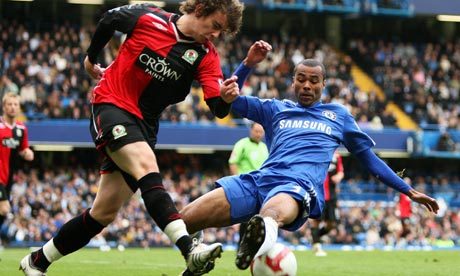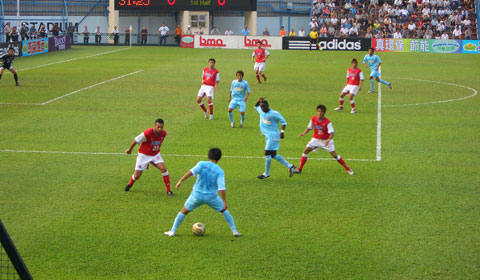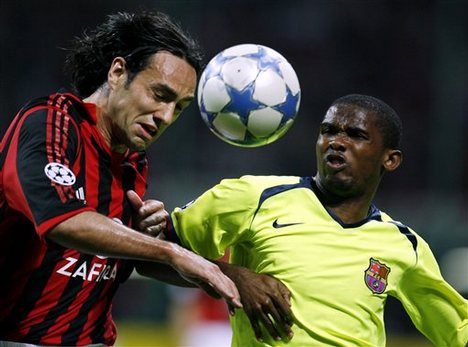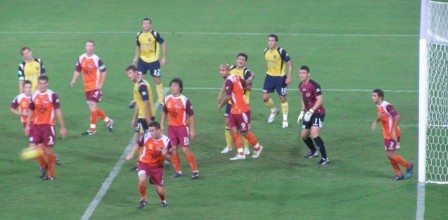-
Recent Articles
The Midfielder as Centerback
 Marcelo Biesla and Josep Guardiola are both managers who play a very high line with their respective sides and who both demand that all players be technically proficient with the ball. Part of playing...
Marcelo Biesla and Josep Guardiola are both managers who play a very high line with their respective sides and who both demand that all players be technically proficient with the ball. Part of playing...Understanding the 4-4-2 Diamond
DEFENCE Despite the fact that there are four ways to play a diamond formation on FM, the differences between them are few and usually subtle. As a starting point, one thing each of them do have...3 at the back and the 4-4-2 Diamond
 Last week Chelsea v Liverpool became the biggest tactical talking point of the season. Liverpool revived the the 3 man defence that Kenny debuted against Stoke. While with the introduction of Torres for £50m...
Last week Chelsea v Liverpool became the biggest tactical talking point of the season. Liverpool revived the the 3 man defence that Kenny debuted against Stoke. While with the introduction of Torres for £50m...How To Set Up A Back Four
 Last year, I wrote a guide about how to play a simple 4-4-2. One of the major components of that is the back four. In fact, most modern formations build upon four defenders; two full backs and two centre...
Last year, I wrote a guide about how to play a simple 4-4-2. One of the major components of that is the back four. In fact, most modern formations build upon four defenders; two full backs and two centre...Building Your Defence: Full Backs
 The modern full back is quickly becoming one of the most important players on the team sheet, infact even back in the days of Brian Clough, fat ed' argued that because of the space these players get in the final...
The modern full back is quickly becoming one of the most important players on the team sheet, infact even back in the days of Brian Clough, fat ed' argued that because of the space these players get in the final...
JOIN 12,748 READERS - SUBSCRIBE NOW TO OUR FOOTBALL MANAGER NEWSLETTER
Get the latest FM news & best community content delivered directly to your e-mail inbox!
Building Your Defence: The Defensive Line
Written by: Thomas Levin
Category: Formations
Posted on: June 2, 2010

June 2, 2010
The defensive line dictates the starting position of your defence. Some teams will play with high lines looking for the defence join the attack or get the ball high up the pitch. Others will play with a deep line looking to act as a wall between the goal and giving the attack less room behind them to beat them. I take a quick look at the defensive line and the advantages and considerations between the two.
The position of the defensive line can be important in setting up your tactics, you may want to make yourself hard to break down and parking a bus in front of goal or instead if you want to win the ball back, harry players and find yourself on the attack quickly. Each of these lines are relative to the way your intended style of play 10 notches to use the old slider system would be high when your looking to go all out defence.
Playing a deep line
Playing a deep defence can be useful when you want to stand strong in front against strong attacking teams. Allowing your players to sit in front of the goal with little behind for strikers to move into, if they do get past the little space to make up is much easier for other defenders to cover. Useful against fast strikers, defenders will want to face these players, instead of seeing them quickly get away in a high space behind them which would mean they would need to chase.
The good solid shape and making yourself difficult to break down, a deep line can be useful if you are looking to neutralise and frustrate your opposition. Having hold of the ball might not be the best tactical option for your side. The position of your players might be a much more important factor in defence as well as attacking, allowing you to prevent a possession hungry side from penetrating with any real opportunity.
The advantages of the deep defensive line can be demonstrated best by Inter Milan’s second leg defeat to Barcelona. Even though the defeat is misleading, Mourinho went through to the final by frustrating Barcelona. Playing deep which meant their was no space for the strikers to run into, while Lucio and Samuel were strong in the air to neutralise any aerial threat.
The deep defence can also be beneficial in creating space for your own team. Stepping the side back from a packed midfield and giving options to pass too and allowing more space to find in front of you for a players to move into during the build up. It can also create a lot space in dragging strikers further forward and against teams that may player a AMC or a 4-5-1 creating space between these two bands could make it harder for the two bands to interact.
Playing deep can invite a lot of pressure onto your defence and if you haven’t got the space behind the midfield covered properly that pressure can be dangerous. Playing deep you really need to have a disciplined defence who can stay strong and well shaped throughout.
Playing a high line
If you are looking to reduce the space of the opposition then high lines can condense the space of the midfield and using the offside trap compress further up the park.
Highlighted by Barcelona this season, but it is something that has been deep rooted in the Total Football of the Dutch of the 1970s. Playing high up the field meant that when the Dutch didn’t have the ball the opposition were squeezed into a narrow band, making it much easier to hassle and press. This would cut down the amount of time a player had to pick out a pass. Using the offside trap to great affect to neutralise the limitations of being so far forward, although the modern game looks to advantage attacking football and instead forces the defenders to defend instead of building a trap of stalemate.
Good positioning and intelligence are key attributes in order to know when to move out, if the opposition is able to get behind the defence there is much space for a quick striker to get away.
Playing high up the pitch can help the defence join in with the build up of an attack or if you lose the ball, quickly win it back, but it is important to have strong, quick defenders to cover anything that maybe hit over the defensive line or a good sweeper keeper who can pounce and cover any long balls over the back covering the space behind the defence.
The mid range between the two can allow you to do a little bit of both of these elements and can be a reasonable when your players aren’t as skilled as they need to be to play either very high or very low. Useful for giving freedom to players such as full backs to be in a position to quickly counter attack and move the play through transition of stages quickly.
Many managers will talk about building their tactics from the back and a defensive line is just that, it will dictate the way the rest of you side will setup from the midfield to the strikers. How fast you look to win the ball back and hassle, while also building the barrier in front of goal. Defensive line is the start but much importance still must be placed on the position and shape of the rest of the team.
About The Author: Thomas Levin
With 10 years of CM/FM blogging under his belt, Thomas is the owner of FM Pundit. He has developed a reputation around the community and can be seen on many of the forums, helping out all with his advice on tactics, transfers, finances and strategy. From the red side of Liverpool living on past glories, it's very similar to his own FM career. Tom has now joined forces with Gareth and Milhail to blog about the real football world at Touchlineshouts
Download Our Tactical Theorems '10 eBook Absolutely Free

Presenting the most comprehensive tactic design and match strategy guide to the Football Manager series ever created!
Written by FM match engine beta testers, it's 60+ pages of easy-to-read concepts and ideologies for getting your team playing exactly how you want each match! It's been downloaded over 100,000+ times to date!
Find out more information about our tactical eBook
and download Tactical Theorems '10 right now!
Written by FM match engine beta testers, it's 60+ pages of easy-to-read concepts and ideologies for getting your team playing exactly how you want each match! It's been downloaded over 100,000+ times to date!
and download Tactical Theorems '10 right now!





